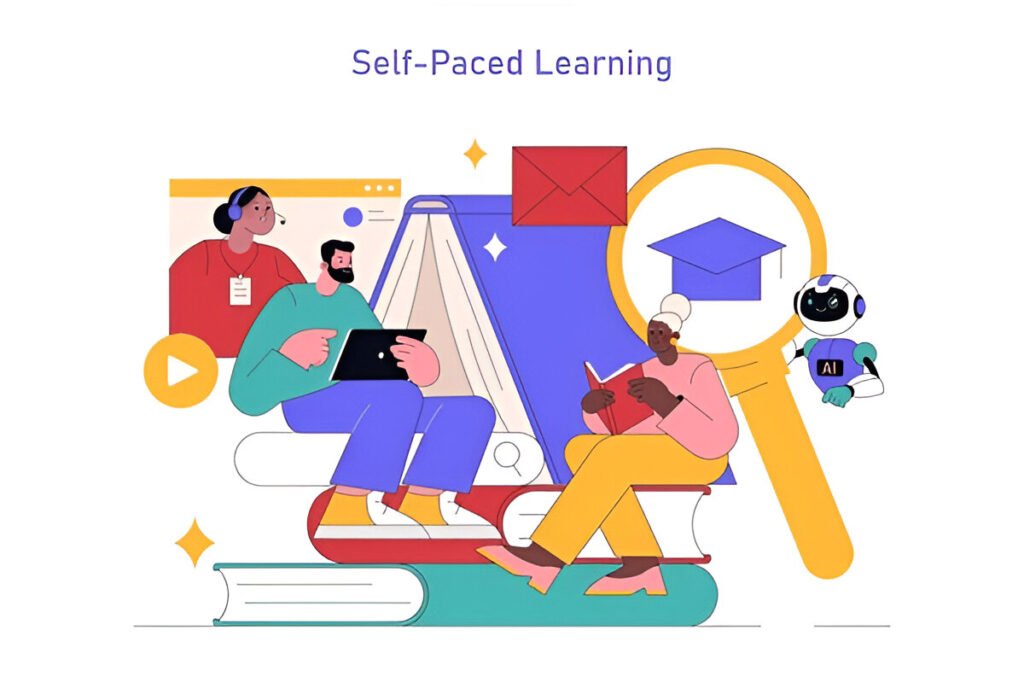It’s 9:00 PM. You’ve just finished dinner, settled in with your laptop, and opened your self-paced online course. You promise yourself you’ll study for at least an hour. Ten minutes in, your phone pings. A quick scroll on Instagram turns into a 45-minute detour, and suddenly the night is gone.
If this sounds familiar, you’re not alone. Staying focused in self-paced courses is one of the biggest challenges for online learners. Without fixed deadlines or classroom accountability, motivation can fade fast. The good news? By applying the right self-paced learning tips, you can stay productive, complete your courses, and actually retain what you learn. This guide will give you research-backed strategies, personal insights, and practical tools to help you thrive in a self-paced learning environment.
Why Staying Focused in Self-Paced Learning Matters
Self-paced learning offers incredible flexibility. You can learn anytime, anywhere, and at your own speed. According to Harvard Business Review, flexibility is one of the top reasons professionals choose online learning. However, that freedom comes with a hidden cost—lack of structure.
Without deadlines or peer pressure, it’s easy to procrastinate or drift away from your goals. A study by the U.S. Department of Education found that students in self-paced online programs often drop out at higher rates compared to those in instructor-led courses. The main reason? Loss of focus and motivation over time.
If you’re serious about finishing your course—whether it’s for career growth, academic credit, or personal interest—you need strategies that help you stay on track from start to finish.
Understanding the Focus Challenge in Self-Paced Learning
Self-paced learners face unique obstacles compared to traditional classroom students. First, there’s decision fatigue—having to decide each day when and how much to study. Then there’s distraction overload, especially when learning online, where social media, email, and entertainment are just a click away.
There’s also the issue of self-motivation. Without an instructor checking in or classmates to compare progress with, you have to be your own coach, cheerleader, and accountability partner. These challenges are real, but they can be overcome with intentional habits and a structured approach.
Practical Self-Paced Learning Tips to Stay Focused
1. Create a Study Schedule and Treat It Like a Class
One of the best self-paced learning tips is to set fixed study times in your calendar. Treat them like non-negotiable appointments. The Cornell Learning Strategies Center recommends building consistent study blocks into your routine so they become a habit, just like going to work or the gym.
For example, you might dedicate 7–8 AM for learning before work or 8–9 PM after dinner. Over time, your brain will associate that time with focused study.
2. Break Large Goals into Smaller Milestones
A self-paced course with 50 lessons can feel overwhelming. Break it into smaller milestones—like completing one lesson per day or a module per week. Celebrating these small wins keeps motivation high and prevents burnout.
Research from Stanford University shows that people are more likely to stick with long-term goals when they track and celebrate small successes along the way.
3. Use the Pomodoro Technique for Better Focus
The Pomodoro Technique involves studying for 25 minutes, then taking a 5-minute break. After four “Pomodoros,” take a longer break of 15–30 minutes. This method helps maintain mental sharpness and prevents fatigue during long study sessions.
Many learners find that they can push distractions aside for short bursts of time more easily than trying to focus for hours straight.
4. Eliminate Digital Distractions Before You Start
Turn off notifications, put your phone in another room, and use website blockers if necessary. Apps like Freedom or Cold Turkey can temporarily block distracting sites so you can focus fully on your coursework.
A Carnegie Mellon University study found that even brief digital interruptions can double the time it takes to complete a task. Protect your focus like it’s your most valuable asset—because it is.
5. Actively Engage with the Material
Passive watching isn’t enough. Take notes, summarize concepts in your own words, and apply what you learn immediately. If the course includes quizzes or exercises, do them without skipping.
Teaching the concept to someone else—even if it’s just explaining it to yourself out loud—also improves retention. This technique, known as the Feynman Method, forces you to process information more deeply.
Tools and Resources for Staying Focused
| Tool/Resource | Best For | Why It Works |
|---|---|---|
| Google Calendar | Scheduling study blocks | Creates structure and accountability |
| Notion | Organizing notes & milestones | Keeps learning materials and goals in one place |
| Pomofocus.io | Pomodoro timer | Breaks study into manageable intervals |
| Freedom App | Blocking distractions | Prevents time-wasting online habits |
| Evernote | Quick note-taking | Easy to capture and organize course insights |
Expert Insights on Self-Paced Learning Success
Dr. Barbara Oakley, professor and author of Learning How to Learn, emphasizes that focus is a skill you can train. She recommends alternating between focused mode (intense concentration) and diffuse mode (relaxed thinking) to let your brain process new information more effectively.
Similarly, Dr. Richard E. Mayer, a learning scientist at the University of California, Santa Barbara, points out that active learning strategies—like self-testing and summarizing—are significantly more effective than simply re-reading or watching videos.
Case Example: How Marcus Completed a Self-Paced Data Science Course in 3 Months
Marcus, a full-time marketing professional, enrolled in a self-paced data science course to transition into analytics. At first, he struggled with irregular study habits. Weeks would go by without progress, and the course felt endless.
He decided to restructure his approach. Marcus blocked two hours every morning before work, used the Pomodoro Technique, and set a goal to finish one module per week. He also joined an online accountability group where members posted weekly updates.
Three months later, Marcus completed the course, built a portfolio project, and secured a data analyst interview. His key takeaway? Structure and accountability turned self-paced learning from a vague goal into a daily habit.
Final Thoughts and Actionable Summary
Self-paced learning can be your greatest ally in personal and professional growth—but only if you master the art of staying focused. By combining structure, active engagement, and distraction management, you can transform flexibility from a weakness into your biggest strength.
Here’s your action plan:
-
Schedule fixed study times and honor them.
-
Break your course into small, achievable milestones.
-
Use the Pomodoro Technique to maintain focus.
-
Eliminate digital distractions before each session.
-
Engage deeply with the material through notes, summaries, and practice.
Follow these self-paced learning tips, and you’ll not only finish your course—you’ll retain and apply what you’ve learned in real life.
FAQs
Q1: How many hours should I study in a self-paced course?
It depends on your goals and availability. Aim for at least 5–7 hours per week to maintain consistent progress.
Q2: Is self-paced learning as effective as traditional classes?
Yes, if you stay disciplined and actively engage with the content. Research shows that motivated online learners can achieve equal or better results compared to in-person classes.
Q3: What if I lose motivation halfway through?
Reconnect with your “why.” Remind yourself why you started the course, adjust your schedule if needed, and consider joining a study group for accountability.



